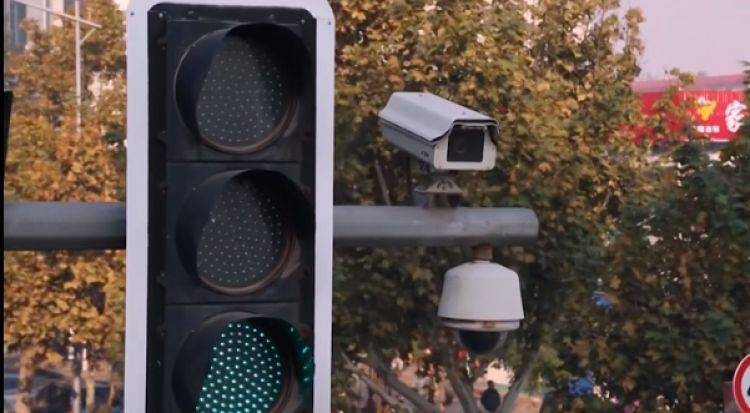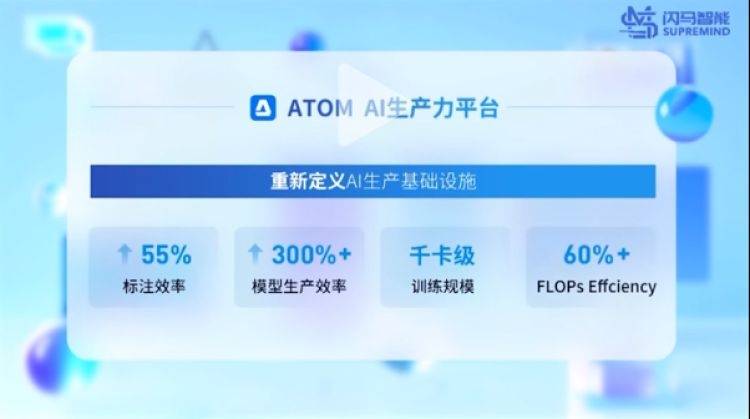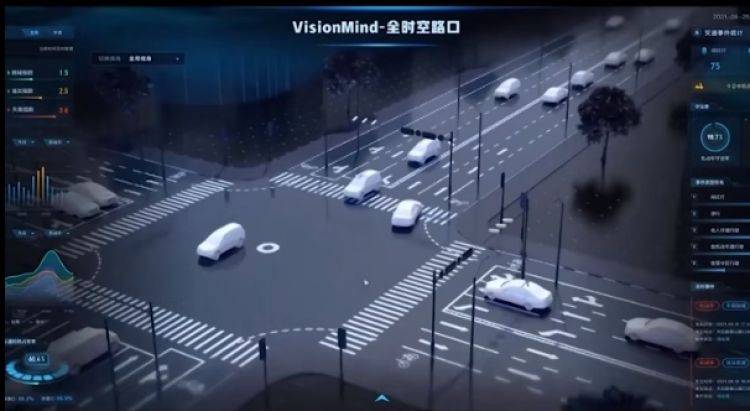 Technology peripherals
Technology peripherals
 AI
AI
 From smart transportation to large perception models, Pudong companies deploy general artificial intelligence
From smart transportation to large perception models, Pudong companies deploy general artificial intelligence
From smart transportation to large perception models, Pudong companies deploy general artificial intelligence
At a busy city street intersection,
Illegal behaviors of motor vehicles, non-motor vehicles and pedestrians are captured instantly;
On many highways across the country,
In case of an unexpected accident,
While dispatching rescue vehicles efficiently,
It can also predict future traffic conditions.
How are these done?
Let’s see how Pudong Enterprise Shanma Intelligence performs identification and analysis based on AI technology,
Let these scenarios be applied one by one.
There are a lot of public camera videos in the city
A large amount of video data is generated on the Internet every day
How to make full use of these video resources?

At the 2023 World Artificial Intelligence Conference
Shanma Intelligence announced
ATOM AI productivity platform.
Ensuring the accumulation of technical achievements and precipitation of data assets is the main goal of the platform
Break resources into parts and make effective reuse a reality

Based on ATOM AI productivity platform,
Shanma Intelligence itself has also done large-scale model exploration,
Developed SupreMeta perceptual large model,
To achieve more accurate target recognition and tracking
Gradually establish a complete "AI industrialization" system,
It can flexibly adapt to the needs of multiple downstream scenarios.

While using,
Can also provide help to other industries
For example, fields such as finance, education, and medical care need to train more models,
Provide more technical services and support.
produced
Pudong New Area District Committee Propaganda Department (Culture, Sports and Tourism Bureau)
Rewrite the content without changing the original meaning. The language that needs to be rewritten is Chinese, and the original sentence does not need to appear
The content that needs to be rewritten is: Oriental Finance·Pudong Channel
Form a team
The rewritten content is: the project director is Yu Pei and the producer is Wang Jingwen
Director Zhang Yuying and intern Xu Chaoyu worked together to create Li Zhengjing’s work
The content that needs to be rewritten is: Visual Design/Yu Jia Project Promotion/Zhang Peijuan
The content is rewritten as follows: According to a report released by Pudong
The above is the detailed content of From smart transportation to large perception models, Pudong companies deploy general artificial intelligence. For more information, please follow other related articles on the PHP Chinese website!

Hot AI Tools

Undresser.AI Undress
AI-powered app for creating realistic nude photos

AI Clothes Remover
Online AI tool for removing clothes from photos.

Undress AI Tool
Undress images for free

Clothoff.io
AI clothes remover

Video Face Swap
Swap faces in any video effortlessly with our completely free AI face swap tool!

Hot Article

Hot Tools

Notepad++7.3.1
Easy-to-use and free code editor

SublimeText3 Chinese version
Chinese version, very easy to use

Zend Studio 13.0.1
Powerful PHP integrated development environment

Dreamweaver CS6
Visual web development tools

SublimeText3 Mac version
God-level code editing software (SublimeText3)

Hot Topics
 1386
1386
 52
52
 Using Shengteng AI technology, the Qinling·Qinchuan transportation model helps Xi'an build a smart transportation innovation center
Oct 15, 2023 am 08:17 AM
Using Shengteng AI technology, the Qinling·Qinchuan transportation model helps Xi'an build a smart transportation innovation center
Oct 15, 2023 am 08:17 AM
"High complexity, high fragmentation, and cross-domain" have always been the primary pain points on the road to digital and intelligent upgrading of the transportation industry. Recently, the "Qinling·Qinchuan Traffic Model" with a parameter scale of 100 billion, jointly built by China Vision, Xi'an Yanta District Government, and Xi'an Future Artificial Intelligence Computing Center, is oriented to the field of smart transportation and provides services to Xi'an and its surrounding areas. The region will create a fulcrum for smart transportation innovation. The "Qinling·Qinchuan Traffic Model" combines Xi'an's massive local traffic ecological data in open scenarios, the original advanced algorithm self-developed by China Science Vision, and the powerful computing power of Shengteng AI of Xi'an Future Artificial Intelligence Computing Center to provide road network monitoring, Smart transportation scenarios such as emergency command, maintenance management, and public travel bring about digital and intelligent changes. Traffic management has different characteristics in different cities, and the traffic on different roads
![Guangdong is actively working hard! Promote the acceleration of the construction of a leading place for innovation in the general artificial intelligence industry [Intelligent Computing Center Industry Market Analysis Appendix]](https://img.php.cn/upload/article/000/887/227/169994745364509.jpg?x-oss-process=image/resize,m_fill,h_207,w_330) Guangdong is actively working hard! Promote the acceleration of the construction of a leading place for innovation in the general artificial intelligence industry [Intelligent Computing Center Industry Market Analysis Appendix]
Nov 14, 2023 pm 03:37 PM
Guangdong is actively working hard! Promote the acceleration of the construction of a leading place for innovation in the general artificial intelligence industry [Intelligent Computing Center Industry Market Analysis Appendix]
Nov 14, 2023 pm 03:37 PM
The content that needs to be rewritten is: Image source: Photo Network On November 13, the official website of the Guangdong Provincial People's Government released the "Implementation Opinions on Accelerating the Construction of a Leading Place for Innovation in the General Artificial Intelligence Industry" to build Guangdong into a national general artificial intelligence industry. Leading the innovation of the artificial intelligence industry, it will build a national intelligent computing hub, a data zone in the Guangdong-Hong Kong-Macao Greater Bay Area, and a national demonstration highland for scenario applications, forming a good development pattern of "computing power interconnection, algorithm open source, data fusion, and application emergence." The implementation opinions also put forward specific goals for the development of the general artificial intelligence industry in Guangdong: by 2025, the scale of intelligent computing power will be the first in the country and the world's leading, the general artificial intelligence technology innovation system will be relatively complete, and high-level artificial intelligence application scenarios will be further expanded, and the core Industry scale
 How to implement smart cities and smart transportation using JavaScript
Jun 15, 2023 pm 06:16 PM
How to implement smart cities and smart transportation using JavaScript
Jun 15, 2023 pm 06:16 PM
With the accelerated development of urbanization and the rapid growth of urban population, the concepts of smart cities and smart transportation have been gradually proposed and widely discussed. The purpose of smart cities and smart transportation is to improve the quality of urban life and transportation efficiency through the application of information technology. As one of the representatives of front-end development languages, JavaScript has also become an indispensable part of smart cities and smart transportation. JavaScript Applications in Smart Cities Smart cities cover a wide range of areas, from municipal engineering, urban management, public utilities to transportation.
 How does graph intelligence move toward general artificial intelligence? This study at the Bund Conference has useful information
Sep 10, 2023 pm 03:41 PM
How does graph intelligence move toward general artificial intelligence? This study at the Bund Conference has useful information
Sep 10, 2023 pm 03:41 PM
“Generative artificial intelligence is the most important technological revolution in the past 40 years.” This is the latest judgment of Microsoft co-founder Bill Gates. When intelligence emerges, how to promote scientific research and application innovation has become the focus of the industry. On September 7, at the "New Generation Data Base - Exploring the Application and Development of Graph Intelligence" sub-forum at the 2023 Bund Conference, Ant Group presented a fusion research - "Large Graph Model" (Large Graph Model, referred to as LGM). This research combines graph computing with graph learning and large language models, using the generation capabilities of large language models and the correlation analysis capabilities of graph computing to provide more intuitive and comprehensive information presentation and more accurate insights, thereby better Solve massive and complex digital application problems. at present
 The application practice of Go language in the field of smart city and smart transportation
Jun 21, 2023 am 09:15 AM
The application practice of Go language in the field of smart city and smart transportation
Jun 21, 2023 am 09:15 AM
With the acceleration of urbanization and the continuous advancement of science and technology, the construction of smart cities has become one of the important goals of current social development. Among them, smart transportation, as an important part of smart cities, plays an important role in connecting people and travel modes, improving urban operating efficiency, and optimizing the urban transportation environment. In the field of smart transportation, Go language is gradually becoming the language of choice for developers, and its application has also shown strong advantages in practice. 1. Analysis of the applicability of Go language in the field of smart transportation. As an open source, efficient, and highly concurrent static programming
 Artificial Intelligence is the key to improving safety in the transportation industry!
Apr 12, 2023 am 10:43 AM
Artificial Intelligence is the key to improving safety in the transportation industry!
Apr 12, 2023 am 10:43 AM
Last week, e-scooter giant Lime announced plans to trial a new custom computer vision platform to detect dangerous behavior by users riding on sidewalks. Such safety mechanisms, capable of alerting cyclists to infractions or even slowing down, are much needed given a string of dangerous accidents that have cast aspersions on the popular mode of urban transport. Artificial intelligence can play an important role not only in electric scooters. Fatal rail accidents occur with alarming frequency. And road traffic-related accidents remain the leading cause of premature death globally, especially among young people. Fortunately, solutions inspired by artificial intelligence and computer vision are emerging that are designed to improve safety across all modes of transportation, both for pedestrians and
 Toward general artificial intelligence, Baidu Feipiao + Wenxin create the largest AI community in China
Aug 28, 2023 am 09:01 AM
Toward general artificial intelligence, Baidu Feipiao + Wenxin create the largest AI community in China
Aug 28, 2023 am 09:01 AM
At the WaveSummit2023 Deep Learning Developer Conference held on August 16, Wang Haifeng, chief technology officer of Baidu and director of the National Engineering Research Center for Deep Learning Technology and Applications, said that large language models have four core basic capabilities of understanding, generation, logic, and memory. Bringing the dawn of general artificial intelligence. The Feipiao ecosystem brings together 800 developers and creates 800,000 models. In Wang Haifeng’s view, the typical capabilities of artificial intelligence, such as creation, programming, problem solving, planning, etc., all rely on the four major components of understanding, generation, logic, and memory to varying degrees. Core basic competencies. Take problem solving as an example. From reading the question, to answering the question, to finally writing the answer, artificial intelligence is nothing more than a combination of the four major abilities of understanding, memory, logic, and generation. How to Get the Big Four in Artificial Intelligence
 The future of artificial intelligence: general artificial intelligence
Apr 14, 2023 pm 02:28 PM
The future of artificial intelligence: general artificial intelligence
Apr 14, 2023 pm 02:28 PM
To gain a true understanding of artificial intelligence, researchers should turn their attention to developing a basic, underlying AGI technology that can replicate human understanding of the environment. Industry giants like Google, Microsoft, and Facebook, research labs like Elon Musk’s OpenAI, and even platforms like SingularityNET are all betting on artificial general intelligence (AGI)—the ability of intelligent agents to understand or learn any intellectual task that humans cannot accomplish, which represents the future of artificial intelligence technology. Somewhat surprisingly, however, none of these companies are focused on developing a basic, underlying AGI technology that replicates human contextual understanding. This may explain why



